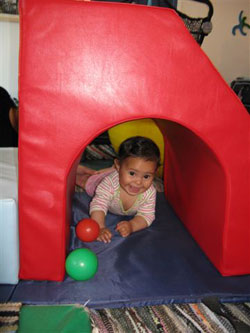6-12 month
Recommended exercises for ages 6-12 months:
Examples for exercises that will help you, the parents and care takers, to reach the full potential of the GYMBOX.
The parent is responsible for the correct performance of the exercises.
No exercise should be attempted without the will and the cooperation of the infant.
All the precautions that are specified on the label that is glued to the product must be followed.
It is forbidden to play with the product or climb on it without adult supervision.
While in use, the Gymbox must be placed on a carpet or soft surface.
An Infant who can’t sit on his own should not be seated during any exercise
At the beginning of this period most babies manage to sit upright properly and independently for the first time (without support). During the period the babies start to crawl and some of them even stand and walk with help, the infant should be encouraged to move and crawl as much as possible.
The following exercises are offered as an addition to the free movement of the infant in the GYMBOX.
The more he’ll experience – the more he’ll gain self confidence. The infant’s trust in his abilities and performances will also gain.
Every baby has his own development scale, at the beginning it is recommended to carry out the practices and work on the exercises that are suited to the ages of 0-6 months.
Ball pool : games with balls
Exercise No. 1
Lay/seat the baby in the ball pool, let him hold a ball in his hand. Play with him and encourage him to play with the balls alone. Take a ball from the pool and roll it gently against the surface of his body while announcing every body-part that is touched.
Exercise No. 2
Place a ball on the baby’s hand (in one hand and then the other). Let him feel the weight of the shape and announce the color of the ball.
Exercise No. 3
Encourage the baby to hold the ball in both his hands. By removing the hands from each other show him how the ball falls down and encourage him to do so himself.
Exercise No. 4
Roll some balls on the edge of the pool. Enable him to follow the balls with his eyes and then catch them.
Place the balls on the edge of the pool and encourage the baby to throw/pass them into the pool and out of the pool.
Exercise No. 5
Roll the ball down the slope and let the baby follow the ball with his eyes, after a number of times show him how to catch them.
Ball pool: exercises that encourage crawling
Exercise No. 6
Lay/seat the baby inside the ball pool and encourage him to enter and exit the pool.
The ball pool’s edge is challenging and demands greater movement skills from the baby in order to pass it. Place the different kinds of half-cylinders/cylinders around the pool in order to help and encourage the baby to crawl and to prevent the possibility of rolling or falling.
Developmental contribution
The ball pool enables sensory stimulation with the help of an unstable surface (which also helps to improve crawling abilities).
The combination of the different possibilities of entering and exiting the ball pool encourages crawling. Through climbing and descending (coming down) the baby learns about the functions of the arms and legs and improves those functions. The exercises help the baby to deal with difficulties and give him the self confidence to attempt and dare.
The ball games help in developing light motorial skills, eye-hand contact and spatial perception. When the game includes an adult it encourages learning through imitation.

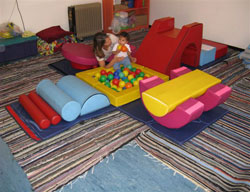
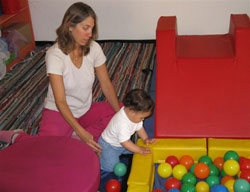
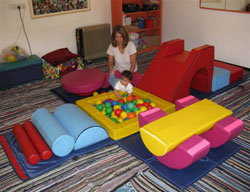
Exercises that encourage crawling. Cylinders/Half-cylinders/pink half circles.
Exercise no. 1
Attach the cylinders and the half-cylinders in different ways and create a crawling-encouraging course which turns in the direction of the pool. Encourage the baby to crawl in your direction/ call his name/ offer him some balls or toys. In order to strengthen the connection between the eye and the hand, balls can be rolled from the cylinder in the pool’s direction while enabling the baby to follow the ball’s path and even to crawl and attempt catching the ball.
Exercise no. 2
Turn over the balancing swing (half yellow cylinder and two half pink circles) and encourage the baby to pass over it by crawling/climbing. Place the baby on his knees and put some balls or toys on the half-circles. Encourage the baby to catch them or drop them to the floor. A baby that is already crawling can pass over the half yellow circle by underbelly crawling. Later on he will do this by regular crawling. Infants who start to practice walking can lean their arms on the half circles and pass their legs over the half cylinder.
Exercise no. 3
Lay/seat the baby behind the cylinder, let him lay his hands on it and show him how to roll the cylinder backwards and forwards, draw the cylinder closer to the infant and then distance it.
Repeated exercise will enable the shifting of weight to the arms and the lifting of the hips from the floor. It is recommended as a preliminary stage before regular crawling (on the knees), sitting on knees and sitting on heels.
Execise no. 4
Encouragement of weight shifting before crawling
Lay the baby on his belly (on the cylinder), roll it backwards and forwards so that the weight is shifted to the hands/arms at one time, and then to the knees and feet on the other. There are babies who need a wider maneuvering space, in this case the smaller half circles (turquoise) can be placed on the bigger ones (yellow) which constitute part of the swing. In this case place the baby on the smaller half circle (turquoise) and move him gently. If the baby doesn’t extend his arms forwardly,The process is to be repeated a number of times.
Exercise no.5
After the baby starts to feel comfortable rolling backwards and forwards on the cylinder , place some balls or toys at different intervals on the cylinder. The baby will try to reach them while rolling forwards and may even try to catch them.
Exercise no. 6
Encouragement of weight shifting before crawling
Seat the baby (if he can sit on his own) on his knees with his arms leaning on the cylinder. While lifting his hips, enable him to experience the shifting of his weight forwardly. Lay the cylinder near the ball pool so that the infant can roll over the cylinder and into the pool
.
Exercise no. 7
Seat the baby (if he can sit on his own) on the cylinder in a riding posture, hold him and rock him gently
Exercise no. 8
Place the wheels next to each other and lay the baby on his belly above them. Lift the arms gently one after another and then do the same for the legs. Roll the baby gently over the cylinders and enable him to feel the rocking feeling in different parts of his body.
Developmental contribution
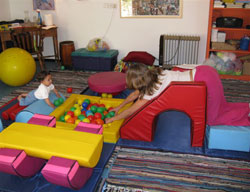
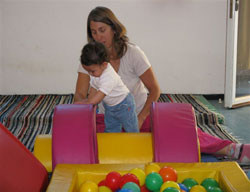
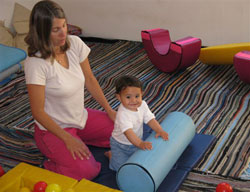
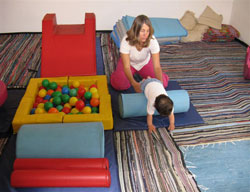

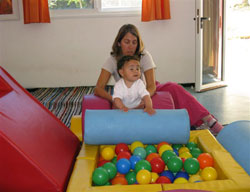
Balancing exercises, A swing which is constituted of two pink half circles and a yellow/turquoise half cylinder
Exercise No. 1
Seat the baby (if he can sit on his own)/Lay the baby on his belly/on his back and swing him gently or change positions.
Exercise No. 2
Place a little cylinder, toy or ball in front of the baby (on top of the swing) and encourage him to move it and maybe even reach it.
Exercise No. 3
Let the baby hold a ball in his hands/ let him catch a ball in motion/ roll the ball on a swing.
Exercise No. 4
Lay the baby on his belly with the support of his arms, swing him from side to side while holding his hips. Encourage the baby to disconnect his arm as a preparation for underbelly-crawling and for improving the weight shifting that had already been learnt at the rolling-over stage.
A round surface for balancing
Exercise no. 5
Seat the baby (only in cases where he sits on his own)/ lay the baby/ hold him and swing him gently while changing positions/ up and down/ rotational movements to the sides/ at different speeds.
Exercise no. 6
Seat the baby (if he can sit by himself)/ stand the baby on his feet (if he can stand on his own), support him in balance and swing him gently. Supervise and support the baby seriously.
Exercise no. 7
Lay the balls on the surface and roll them in the baby’s direction which is opposed you. During the first stage the baby will follow the ball’s motion and then try to catch them, later on he’ll try to roll them himself in your direction.
Exercise no. 8
Place the balls on the surface and show the baby how to roll them by moving the surface in different directions- upwards, downwards, rightwards and leftwards.
Exercise no. 9
Lean the baby on the surface with his knees on the floor and enable him to practice his balancing skills while the surface moves in different directions. Show him how you turn the surface and encourage him to turn it himself.
Exercise no. 10
Stand the baby up if he can stand by himself, hold him by the hips or arms while in balance and swing him gently. Be sure to properly hold and supervise him. The baby can also lean on the surface with his arms and walk around it
A swing composed of pink half circles
(Attached half circles or two half circles which constitute two swings)
In accordance with the baby’s body shape and the position where he feels more comfortable.
Exercise no. 11
Seat the baby (if he can sit on his own) on the half pink circles and swing him gently. When the baby feels secure enough he can place his hands on the circle’s sides and swing by himself.
Exercise no. 12
Seat the baby near the half circle, place his arms on the circle’s sides and show him how to swing the half circle.
A circle (wheel) composed of two half circles
The circle is placed on the mattress/carpet
Exercise no. 13
Place the circle on the mattress, put the baby inside the circle and let him play (while in the circle) with balls or toys which are located on the edge. He can be taken in and out of the circle.
Exercise no. 14
If the baby can stand by himself, give him a hand and help him to get in and out of the circle by walking or crawling.
Exercise no. 15
If the baby can walk by himself, give him a hand and help him walk on the edge of the circle.
For the ones who are advanced- the walking can be improved by walking with one foot on the circle and the other foot inside the circle.
The circle (wheel) stands on the mattress/carpet
Exercise no. 16
Let the baby crawl into and out of the circle.
Exercise no. 17
Help the baby to roll inside the circle with a “pencil roll” (the arms and legs are straight).
Exercise no. 18
Hold the baby, place him on his belly (on the circle) and roll him backwards and forwards very gently and slowly.
Developmental contribution
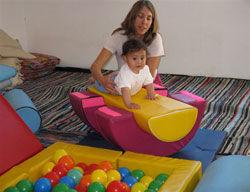
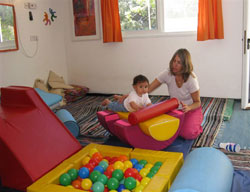
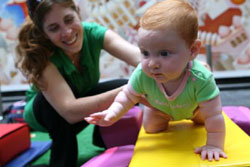

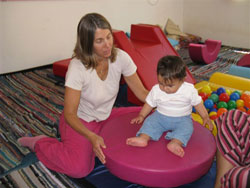


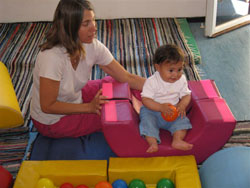
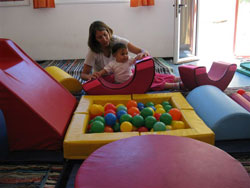
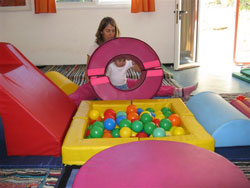
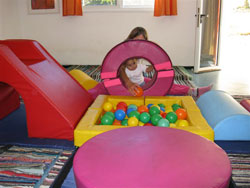
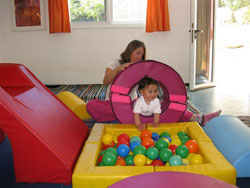
Stairs (toy blocks) and a slide (a slope for climbing and crawling in a tunnel)
Every toy block can be played with independently, or they can be laid one next to each other and become stairs. For crawling babies the blocks constitute a challenging and cheerful obstacle.
Exercise no. 1
Place the baby on his knees while he’s leaning his chest and arms on the block. Place some balls and toys on the block. It encourages the lifting and lowering of the hips. It is a very important stage for preparing the baby to crawl and sit.
Exercise no.2
Place some toys and balls on the block, encourage the baby (show him) how to lift them and move them from the block to the floor.
Exercise no. 3
Seat the baby (if he can sit) and hold the baby while he leans on the upper part of the slide or sits on it. Show him how he can roll the balls to the pool by himself. At a later stage he’ll slide down to follow the balls.
Exercise no. 4
Place the baby on the upper part of the slide with his hands on the slope. Lift his hips and move them backwards and forwards gently so that the weight is shifted to the arms/hands. (contributes to the strengthening of the shoulder belt).
Exercise no. 5
Just like with the previous exercise- the wheelbarrow position. The baby is helped in disconnecting both hands (one at a time) and in slowly descending down the slope in the direction of the ball pool. At a later stage the baby will slide on his belly with his head and arms in the front.
Exercise no. 6
Place the baby in the ball pool with his head opposing the slide. Roll some balls on the slide and let the baby follow them with his eyes, encourage him to catch them.
Exercise no. 7
Encourage the baby to practice crawling (on the slope) from the pool’s direction and to slide back to the pool with the legs leading. While the baby is climbing his legs can be supported, that way he will have enough resistance to maneuver comfortably
Developmental contribution
The slide constitutes a challenging and cheering developmental environment for babies who can already crawl and sit. They can improve their movements by climbing and sliding down the slope- in both gravitational directions.
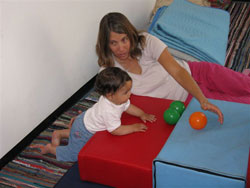


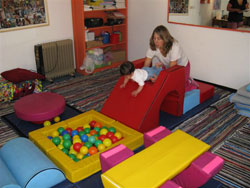
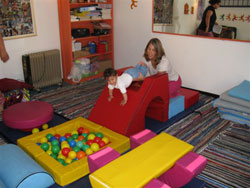

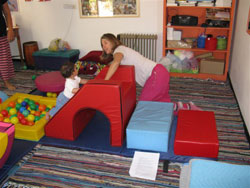
Sliding and crawling through a tunnel
Exercise No. 1
Passing the tunnel from side to side by crawling on the underbelly and later on by regular crawling. Encourage the baby to go through the tunnel by entering one side, calling the baby by his name and rolling some balls so that he can follow them. You can add the peek-a-boo game. (See games that are suitable for the ages of 0-6).
Developmental contribution
Crawling through a tunnel constitutes a challenge and enjoyment for the baby; it encourages the development of physical control and spatial conception/awareness. The peek-a-boo game is considered the first social game and is a source of a lot of enjoyment and bonding between the mother and the child.
